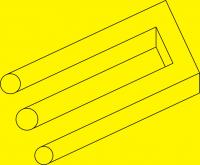Help with Sherline CNC Lathe !
- mimiccalls
- Offline
- New Member
-

- Posts: 3
- Thank you received: 0
Also if anyone out there is interested in writing a few gcodes for me to get started I would be interested in talking price.
Help Please. my email is This email address is being protected from spambots. You need JavaScript enabled to view it. Thank you.......Gary Gatewood
Please Log in or Create an account to join the conversation.
- jmelson
- Offline
- Moderator
-

- Posts: 827
- Thank you received: 161
Whew, where to start?I own a small waterfowl call company and have been hand turning for years. I recently purchased a sherline 4400 cnc lathe with the computer loaded with EMC2. I have read the G Code How tos it came with and......wow I'm lost. So I attempted to download a couple of cad/cam programs thinking that drawing my call parts might be easier, then translating into gcode. I'm so lost. Any help with literature for beginners would be appreciated. It seems as though everything I read goes way more indepth than I need to worry with. All I need to know is how to shape the ooutside and do some simple boring on the inside.
For free-form shapes like this, you really DO want some kind of program to create the G-code
files. Straight lines can be coded up fairly easily by hand, but curves are much harder.
First, you need a CAD program that can accept input in the form you are comfortable
with. Preferably, this CAD program would be able to produce G-code directly, then you
don't have to worry over compatibility between the CAD and the CAM program.
There are separate CAM programs, but these add another level of complexity.
There are a huge number of CAD packages, and now a fair number of low-cost
CAM programs as well. Most of these CAM packages can produce G-code
compatible with LinuxCNC.
I generally do not use a CAD/CAM program, but the typical work I do is VERY
different from yours. I have an old version of Bobcad/CAM, but can't really
recommend it. It does work, however, but is much more cumbersome for
the work I do.
Finally, one possible route would be to build a probe and use the machine
to trace the shapes you make and turn those into programs to duplicate
these shapes.
Jon
Please Log in or Create an account to join the conversation.
- Rick G
-

- Offline
- Junior Member
-

- Posts: 27
- Thank you received: 155
You might want to look here, at the bottom are some links including probing...
www.deweygarrett.com/
Having said that I agree with Jon that a cad/cam package is your best bet to go from idea to finish product.
It seems most cad systems have a steep learning curve at the beginning so you need to select one that you are comfortable with.
You may also be able to scan the profile of your product and use a program to convert the scan to a tool path.
On the plus side I do not think you need to worry about learning a 3d cad system as you can probably do your work with a 2d profile.
Rick G
Please Log in or Create an account to join the conversation.
- BigJohnT
-

- Offline
- Administrator
-

- Posts: 6999
- Thank you received: 1177
Do you have a drawing of a profile? There are DXF to G code converters out there but it is pretty straight forward to write g code with a drawing and some dimensions from the drawing.
The one gotcha on a normal lathe with front tools is arc direction and tool compensation is opposite what you might assume it would be. You don't look down from the top for which side is which but rather lay on the floor (the positive end of the imaginary Y axis) and look up.
John
Please Log in or Create an account to join the conversation.

